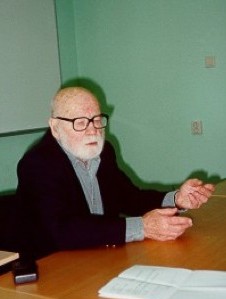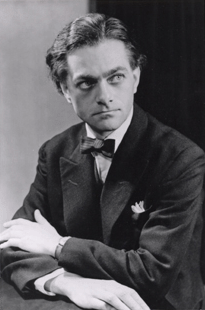Systems theory is the transdisciplinary study of systems, i.e. cohesive groups of interrelated, interdependent components that can be natural or artificial. Every system has causal boundaries, is influenced by its context, defined by its structure, function and role, and expressed through its relations with other systems. A system is "more than the sum of its parts" when it expresses synergy or emergent behavior.
Semiotics is the systematic study of sign processes and the communication of meaning. In semiotics, a sign is defined as anything that communicates intentional and unintentional meaning or feelings to the sign's interpreter.
General semantics is a school of thought that incorporates philosophic and scientific aspects. Although it does not stand on its own as a separate school of philosophy, a separate science, or an academic discipline, it describes itself as a scientifically empirical approach to cognition and problem solving. It has been described by nonproponents as a self-help system, and it has been criticized as having pseudoscientific aspects, but it has also been favorably viewed by various scientists as a useful set of analytical tools albeit not its own science.

Gregory Bateson was an English anthropologist, social scientist, linguist, visual anthropologist, semiotician, and cyberneticist whose work intersected that of many other fields. His writings include Steps to an Ecology of Mind (1972) and Mind and Nature (1979).
Cognitive science is the scientific study either of mind or of intelligence . Practically every formal introduction to cognitive science stresses that it is a highly interdisciplinary research area in which psychology, neuroscience, linguistics, philosophy, computer science, anthropology, and biology are its principal specialized or applied branches. Therefore, we may distinguish cognitive studies of either human or animal brains, the mind and the brain.

Sociocybernetics is an interdisciplinary science between sociology and general systems theory and cybernetics. The International Sociological Association has a specialist research committee in the area – RC51 – which publishes the (electronic) Journal of Sociocybernetics.
A double bind is a dilemma in communication in which an individual receives two or more reciprocally conflicting messages. In some scenarios this can be emotionally distressing, creating a situation in which a successful response to one message results in a failed response to the other, such that the person responding will automatically be perceived as in the wrong, no matter how they respond. This double bind prevents the person from either resolving the underlying dilemma or opting out of the situation.

Thomas Albert Sebeok was a Hungarian-born American polymath, semiotician, and linguist. As one of the founders of the biosemiotics field, he studied non-human and cross-species signaling and communication. He is also known for his work in the development of long-time nuclear waste warning messages, in which he worked with the Human Interference Task Force to create methods for keeping the inhabitants of Earth away from buried nuclear waste that will still be hazardous 10,000 or more years in the future.
Second-order cybernetics, also known as the cybernetics of cybernetics, is the recursive application of cybernetics to itself and the reflexive practice of cybernetics according to such a critique. It is cybernetics where "the role of the observer is appreciated and acknowledged rather than disguised, as had become traditional in western science". Second-order cybernetics was developed between the late 1960s and mid 1970s by Heinz von Foerster and others, with key inspiration coming from Margaret Mead. Foerster referred to it as "the control of control and the communication of communication" and differentiated first order cybernetics as "the cybernetics of observed systems" and second-order cybernetics as "the cybernetics of observing systems".

Andrew Gordon Speedie Pask was a British cybernetician, inventor and polymath who made during his lifetime multiple contributions to cybernetics, educational psychology, educational technology, epistemology, chemical computing, architecture, and the performing arts. During his life he gained three doctorate degrees. He was an avid writer, with more than two hundred and fifty publications which included a variety of journal articles, books, periodicals, patents, and technical reports. He also worked as an academic and researcher for a variety of educational settings, research institutes, and private stakeholders including but not limited to the University of Illinois, Concordia University, the Open University, Brunel University and the Architectural Association School of Architecture. He is known for the development of conversation theory.
Anthony George Wilden was a writer, social theorist, college lecturer, and consultant. Wilden published numerous books and articles which intersect a number of fields, including systems theory, film theory, structuralism, cybernetics, psychiatry, anthropological theory, water control projects, urban ecosystems, resource conservation, and communications and social relations.
The Macy conferences were a set of meetings of scholars from various academic disciplines held in New York under the direction of Frank Fremont-Smith at the Josiah Macy Jr. Foundation starting in 1941 and ending in 1960. The explicit aim of the conferences was to promote meaningful communication across scientific disciplines, and restore unity to science. There were different sets of conferences designed to cover specific topics, for a total of 160 conferences over the 19 years this program was active; the phrase "Macy conference" does not apply only to those on cybernetics, although it is sometimes used that way informally by those familiar only with that set of events. Disciplinary isolation within medicine was viewed as particularly problematic by the Macy Foundation, and given that their mandate was to aid medical research, they decided to do something about it. Thus other topics covered in different sets of conferences included: aging, adrenal cortex, biological antioxidants, blood clotting, blood pressure, connective tissues, infancy and childhood, liver injury, metabolic interrelations, nerve impulse, problems of consciousness, and renal function.
Klaus Krippendorff was a communication scholar, social science methodologist, and cyberneticist. and was the Gregory Bateson professor for Cybernetics, Language, and Culture at the University of Pennsylvania's Annenberg School for Communication. He wrote an influential textbook on content analysis and is the creator of the widely used and eponymous measure of interrater reliability, Krippendorff's alpha. In 1984–1985, he served as the president of the International Communication Association, one of the two largest professional associations for scholars of communication.
Ray L. Birdwhistell was an American anthropologist who founded kinesics as a field of inquiry and research. Birdwhistell coined the term kinesics, meaning "facial expression, gestures, posture and gait, and visible arm and body movements". He estimated that "no more than 30 to 35 percent of the social meaning of a conversation or an interaction is carried by the words." Stated more broadly, he argued that "words are not the only containers of social knowledge." He proposed other technical terms, including kineme, and many others less frequently used today. Birdwhistell had at least as much impact on the study of language and social interaction generally as just nonverbal communication because he was interested in the study of communication more broadly than is often recognized. Birdwhistell understood body movements to be culturally patterned rather than universal. His students were required to read widely, sources not only in communication but also anthropology and linguistics. "Birdwhistell himself was deeply disappointed that his general communicative interests and goals were not appropriately understood." Collaborations with others, including initially Margaret Mead and Gregory Bateson, and later, Erving Goffman and Dell Hymes had huge influence on his work. For example, the book he is best known for, Kinesics and Context, "would not have appeared if it had not been envisaged by Erving Goffman" and he explicitly stated "the paramount and sustaining influence upon my work has been that of anthropological linguistics", a tradition most directly represented at the University of Pennsylvania by Hymes.
The Bateson Project (1953-1963) was the name given to a ground-breaking collaboration organized by Gregory Bateson which was responsible for some of the most important papers and innovations in communication and psychotherapy in the 1950s and early 1960s. Its other members were Donald deAvila Jackson, Jay Haley, John Weakland, and Bill Fry. Perhaps their most famous and influential publication was Towards a Theory of Schizophrenia (1956), which introduced the concept of the Double Bind, and helped found Family Therapy.
The following outline is provided as an overview of and topical guide to communication:

Cybernetics is a field of systems theory that studies circular causal systems whose outputs are also inputs, such as feedback systems. It is concerned with the general principles of circular causal processes, including in ecological, technological, biological, cognitive and social systems and also in the context of practical activities such as designing, learning, and managing.
Systems theory in anthropology is an interdisciplinary, non-representative, non-referential, and non-Cartesian approach that brings together natural and social sciences to understand society in its complexity. The basic idea of a system theory in social science is to solve the classical problem of duality; mind-body, subject-object, form-content, signifier-signified, and structure-agency. Systems theory suggests that instead of creating closed categories into binaries (subject-object), the system should stay open so as to allow free flow of process and interactions. In this way the binaries are dissolved.
Meta-communication is a secondary communication about how a piece of information is meant to be interpreted. It is based on the idea that the same message accompanied by different meta-communication can mean something entirely different, including its opposite, as in irony. The term was brought to prominence by Gregory Bateson to refer to "communication about communication", which he expanded to: "all exchanged cues and propositions about (a) codification and (b) relationship between the communicators". Meta-communication may or may not be congruent with, supportive of, or contradictory to that verbal communication.

This bibliography of sociology is a list of works, organized by subdiscipline, on the subject of sociology. Some of the works are selected from general anthologies of sociology, while other works are selected because they are notable enough to be mentioned in a general history of sociology or one of its subdisciplines.





